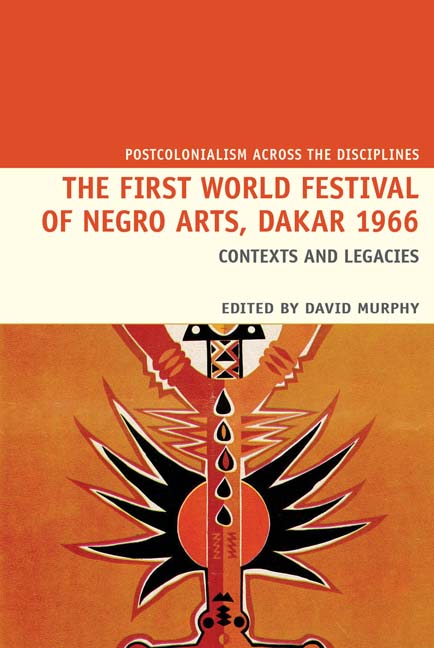Book contents
- Frontmatter
- Contents
- Acknowledgements
- List of Figures
- Notes on Contributors
- Introduction. The Performance of Pan-Africanism: Staging the African Renaissance at the First World Festival of Negro Arts
- I Contexts
- 1 ‘The Real Heart of the Festival’: The Exhibition of L'Art nègre at the Musée Dynamique
- 2 Dance at the 1966 World Festival of Negro Arts: Of ‘Fabulous Dancers’ and Negritude Undermined
- 3 Staging Culture: Senghor, Malraux and the Theatre Programme at the First World Festival of Negro Arts
- 4 Making History: Performances of the Past at the 1966 World Festival of Negro Arts
- 5 ‘The Next Best Thing to Being There’: Covering the 1966 Dakar Festival and its Legacy in Black Popular Magazines
- II Legacies
- Books and Films about the 1966 Festival
- Bibliography
- Index
2 - Dance at the 1966 World Festival of Negro Arts: Of ‘Fabulous Dancers’ and Negritude Undermined
from I - Contexts
- Frontmatter
- Contents
- Acknowledgements
- List of Figures
- Notes on Contributors
- Introduction. The Performance of Pan-Africanism: Staging the African Renaissance at the First World Festival of Negro Arts
- I Contexts
- 1 ‘The Real Heart of the Festival’: The Exhibition of L'Art nègre at the Musée Dynamique
- 2 Dance at the 1966 World Festival of Negro Arts: Of ‘Fabulous Dancers’ and Negritude Undermined
- 3 Staging Culture: Senghor, Malraux and the Theatre Programme at the First World Festival of Negro Arts
- 4 Making History: Performances of the Past at the 1966 World Festival of Negro Arts
- 5 ‘The Next Best Thing to Being There’: Covering the 1966 Dakar Festival and its Legacy in Black Popular Magazines
- II Legacies
- Books and Films about the 1966 Festival
- Bibliography
- Index
Summary
This chapter examines the dance programme at the 1966 Dakar festival, thereby addressing a curious gap in the legacy of this important event. Little is known about the fact that in addition to the visual arts exhibition, the colloquium and the major plays, the festival was also about people performing, and about audiences enjoying dance and music. There were national troupes from a broad range of African nations (which included Senegal, of course, but also Mali, Chad, Ivory Coast, Niger, Sierra Leone, Togo, Cameroon, Gabon, Zaïre, Congo, Zambia, Burundi and Ethiopia). Like much choreographic and musical production throughout Africa in the 1950s and 1960s, these troupes reimagined rural African life and performed ethnic identities while also projecting images of national unity (Askew 2002; Castaldi 2006; Edmonson 2007; White 2008; Djebbari 2011).
In dance and musical performance as in other art forms, Senghor's explicit objective was to showcase the fundamental connections between all black expressive forms, and to celebrate Africa's contribution to world culture. As with all major events, however, the choices made were as much about exclusion as they were about inclusion. At the heart of the festival was a purposeful juxtaposition of ‘traditional’ African arts and European modernist art (Murphy 2015). But what exactly was being juxtaposed? And what choreographic forms were excluded?
In this sense, the festival was very much an extension of colonial ideologies into the postcolonial period. Apter makes a similar point in his monograph on FESTAC 1977, held in Lagos, when he writes that ‘the customary culture which FESTAC resurrected was always already mediated by the colonial encounter, and in some degree was produced by it’ (2005: 6). As Mamdani (1996) has argued, European colonial rule in Africa was structured as a dual legal system (a ‘bifurcated state’), one centred around civil law for the colonizer and a privileged urban minority, and the other centred around customary law for the rural populations. The ‘customary’, however, was not simply a survival of pre-colonial social organization made to work for the benefit of the colonial state. As Mamdani suggests, in the rural areas a despotic mode of government (‘decentralized despotism’) was made to replace pre-colonial forms of ‘distributed authority’. But this was couched in the language of ‘culture’, ‘tradition’ or ‘custom’ so as to legitimize the exclusion of rural populations from full citizenship.
- Type
- Chapter
- Information
- The First World Festival of Negro Arts, Dakar 1966Contexts and legacies, pp. 74 - 92Publisher: Liverpool University PressPrint publication year: 2016



